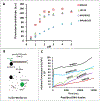Co-incubation of Short Amphiphilic Peptides with Dicer Substrate RNAs Results in β-Sheet Fibrils for Enhanced Gene Silencing in Cancer Cells
- PMID: 40255273
- PMCID: PMC12007892
- DOI: 10.59566/isrnn.2024.0101061
Co-incubation of Short Amphiphilic Peptides with Dicer Substrate RNAs Results in β-Sheet Fibrils for Enhanced Gene Silencing in Cancer Cells
Abstract
RNA can interact with positively charged, amphiphilic peptides to cooperatively assemble into fibrils that enable RNA transport across cancer cellular membranes. RNA decreases the folding energy barrier imposed by the electrostatic repulsion between these charged peptides, thus partaking in RNA-peptide self-assembly along particular pathways in the energy landscape. Specific amphiphilic peptides capable of protecting and transporting RNA across a membrane have Type II' β-turn hairpin forming motifs in their structures, which aids self-assembly into β-sheet fibrils. We employed a set of such cationic, amphiphilic peptides that have random coiled structures in the absence of folding stimuli, to characterize the (peptides):(RNA) assembly. We subjected these complexes to extensive biophysical characterization in vitro and in cell culture. We show that short RNAs (such as Dicer substrate RNAs) can lead these peptides to self-assemble into β-sheet fibrils that have RNA transport capabilities and can act as non-viral delivery vectors for RNA. Modulation in the peptide sequence implicitly alters the way they bind RNA and influence the peptides' ability to transport nucleic acids across membranes.
Keywords: Dicer substrate RNA; RNA interference; RNA-peptide co-evolution; amphiphilic peptides; cancer; peptide folding energy landscape; β-sheet fibrils.
Conflict of interest statement
CONFLICTS OF INTEREST The authors declare no conflict of interest.
Figures






Similar articles
-
Interaction of self-assembling beta-sheet peptides with phospholipid monolayers: the role of aggregation state, polarity, charge and applied field.Langmuir. 2009 Mar 3;25(5):3289-96. doi: 10.1021/la803368r. Langmuir. 2009. PMID: 19437790
-
Tuning β-sheet peptide self-assembly and hydrogelation behavior by modification of sequence hydrophobicity and aromaticity.Biomacromolecules. 2011 Jul 11;12(7):2735-45. doi: 10.1021/bm200510k. Epub 2011 May 24. Biomacromolecules. 2011. PMID: 21568346
-
A Matter of Charge: Electrostatically Tuned Coassembly of Amphiphilic Peptides.Small. 2024 Nov;20(47):e2404324. doi: 10.1002/smll.202404324. Epub 2024 Aug 18. Small. 2024. PMID: 39155426 Free PMC article.
-
Defining the Landscape of the Pauling-Corey Rippled Sheet: An Orphaned Motif Finding New Homes.Acc Chem Res. 2021 May 18;54(10):2488-2501. doi: 10.1021/acs.accounts.1c00084. Epub 2021 Apr 26. Acc Chem Res. 2021. PMID: 33901396 Free PMC article. Review.
-
Elucidating the Structures of Amyloid Oligomers with Macrocyclic β-Hairpin Peptides: Insights into Alzheimer's Disease and Other Amyloid Diseases.Acc Chem Res. 2018 Mar 20;51(3):706-718. doi: 10.1021/acs.accounts.7b00554. Epub 2018 Mar 6. Acc Chem Res. 2018. PMID: 29508987 Free PMC article. Review.
References
-
- Li M Z J, Lv Z, Qin H, Wang X, Shi H. Recent Advances in RNA-Targeted Cancer Therapy. Chembiochem. 2024; 25 (4). - PubMed
-
- Khalil IA, Sato Y, Harashima H. Recent advances in the targeting of systemically administered non-viral gene delivery systems. Expert Opin Drug Deliv. 2019; 16 (10): 1037–1050. - PubMed
-
- Pereira-Silva M, Jarak I, Alvarez-Lorenzo C, et al. Micelleplexes as nucleic acid delivery systems for cancer-targeted therapies. J Control Release. 2020; 323: 442–462. - PubMed
-
- Setten RL, Rossi JJ, Han SP. The current state and future directions of RNAi-based therapeutics. Nat Rev Drug Discov. 2019; 18 (6): 421–446. - PubMed
Grants and funding
LinkOut - more resources
Full Text Sources
